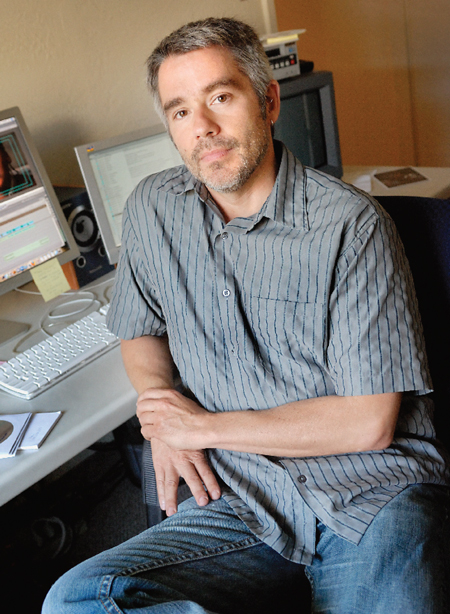Critics have called the new documentary Under Our Skin many things, including “superb” (Time Out New York), “expert storytelling” (Tribeca Film Festival), “artfully shot, dramatic” (Variety) and “a riveting, taut thriller” (Maine International Film Festival).
Director Andy Abrahams Wilson calls it a chance for atonement. “My twin sister contracted Lyme disease years ago,” says the Sausalito resident in the Bridgeway office that houses his production company Open Eye Pictures. “And I didn’t realize how ill she was. In hindsight I wasn’t patient or understanding. I thought maybe she was just being lazy.”
It took Wilson two years, 350 hours of film, and bottomless heartache to learn how wrong he was. The Emmy-nominated producer/director plunged himself into the Lyme disease issue: documenting the lives of sufferers, investigating the controversies about treatment, exposing a conflict-of-interest scandal in the medical establishment—and raising the red flag of epidemic.
“That is not too strong a word, no,” the handsome 44-year-old says solemnly. “The Centers for Disease Control estimate that more than 200,000 people are getting Lyme each year—which makes it the fastest-growing infectious disease in the country, greater than AIDS and West Nile virus combined.”
For those unacquainted with Lyme disease, it can result from a bite of a deer tick infected with the bacterium Borrelia burgdorferi. Symptoms range from rash, fever, chills and body aches to joint swelling, weakness and paralysis. When diagnosed correctly and early, it’s relatively easy to cure; when misdiagnosed, unrecognized or left untreated, the disease can be debilitating or even deadly.
And the North Bay is a potential hotbed of Lyme infection. “Just the other day I was in our neighborhood restaurant having lunch,” says Wilson, “and knew pretty much everyone in there. And when I added it up, I realized that fully half of them had Lyme disease. And that’s just one little slice of Marin life.”
There’s no way of knowing exact numbers, he says. “California doesn’t keep records on Lyme—we’re not required to. But Marin, Sonoma, Napa, Mendocino and Santa Cruz counties are all fertile ground for the deer tick that carries it.”
Unfortunately, Wilson says, Lyme is so hard to diagnose that thousands of people are either undiagnosed or misdiagnosed as having other primary ailments—from chronic fatigue to depression to fibromyalgia to MS and ALS. Marin resident and author Amy Tan, who appears in Under Our Skin, was misdiagnosed for years, suffering effects ranging from headaches to brain lesions, temporarily ending up in a wheelchair. No one in her fleet of doctors even considered that she might have Lyme.
“Amy’s story is sadly typical,” says Wilson. “It’s a twofold failure of the medical community: they don’t know the best ways to test for Lyme, and even when they conclude it is Lyme, they can’t agree on how to treat it.”
The film suggests that the medical board governing treatment for chronic Lyme is guilty of conflicts of interest and in bed with insurance companies—a contention now confirmed by a successful lawsuit brought by Connecticut Attorney General Richard Blumenthal.
As if the misery of Lyme weren’t enough, insurance companies have been refusing to pay for its treatment. “It’s because the medical gatekeepers (primary care providers) haven’t recognized chronic Lyme as a disease,” says Wilson. “Obviously, since it’s a long-term illness, it’s an expensive one. Insurance companies want to pretend it doesn’t exist.”
One of the film’s most compelling profiles is that of Mandy Hughes, a former animal trainer at SeaWorld and Cheryl Tiegs look-alike who suffered neurological damage when her Lyme went undiagnosed for several years. In the film she bitterly repeats what one doctor told her: “There’s no medicine for someone like you. You’re an attractive girl and obviously you don’t feel like you’re getting enough attention.”
Wilson documented Hughes’s story and dozens of others with his camera, recording their struggles and, with the lucky ones, their slow roads to recovery. He also recorded the stories of people whose family members lost their fights with the disease, including a child whose mother claims her daughter died while doctors fought over how to treat her. It was enough to make the veteran filmmaker lose his composure.
“Being around these people for all this time was a real privilege, but also very difficult,” he says. “I finally broke down after the funeral sequence; I was just sobbing in front of my coworkers. I guess I had been absorbing all this heartbreak and just had to let it go.”
Galvanized by what he’d learned, Wilson has gone from dispassionate chronicler of events to crusader for change.
“It’s great to have gotten all the great reviews,” he says, “but this won’t feel like a success to me until it becomes a watercooler topic. People need to see the film and become informed, so we can help curb the epidemic.”
Maybe then, his penance will be complete.
Under Our Skin: An Infectious New Film About Microbes, Money and Medicine will be featured at the Mill Valley Film Festival (mvff.org) October 11 at the Sequoia Theatre in Mill Valley and October 12 at the Rafael Film Center.


